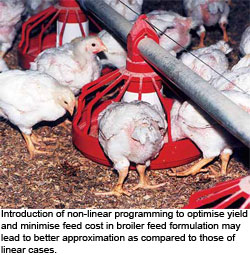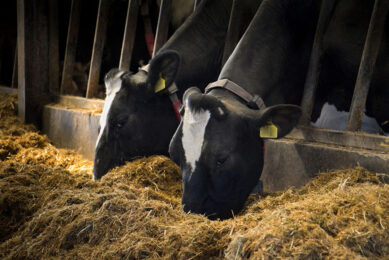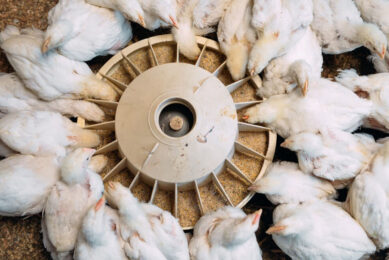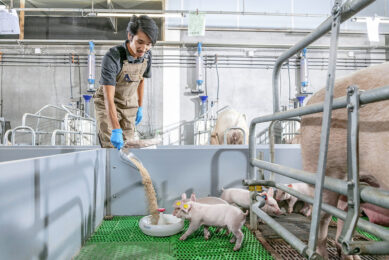Mathematical modelling using non-linear programming

Linear programming applications cannot identify near-feasible solutions that in many instances may be adequate for the user and morecost-effective. In this article non-linear programming is highlighted as being perhaps of better use to formulate the diet of an animal. It gives the benefit of simultaneous inclusion of different kinds of nutrient ingredients, satisfying the feeding standards.
By Dr. Pratiksha Saxena, Department of Mathematics, BLS Institute of Management, Ghaziabad, India
For some years it has been evident that nutrition models are vital to the continued success of the animal industry. Mathematical models of nutrition have been in use for over three decades and have stimulated improvement in feeding animals. However, more complete data sets available in recent years combined with more precise mathematical approaches have now allowed us to improve models of nutrient use tremendously.
Nutritional models vary in complexity. In practice, production models only need details that have significant bearing on consequences of changes arising from inputs to the system or with a scientific model as much detail is necessary to explore the system in new and different ways.
The nutrition planning sequence can be defined into the following steps:
• The definition of nature, scope and trends of the nutritional problem, leading to a preliminary statement of broad objectives.
• Description of the system in which the nutritional condition arises. In the process of tracing causes, the planner begins to sense which programme and policies are relevant to the objective.
• Comparison of the alternatives, which in turn leads to constructing an interrelated nutrition programme.
• Final selection of objectives, programmes and projects emerges after a budgetary and political process in which programmes to attack malnutrition are pitted against other competing claims on resources, and, if necessary, redesigned within actual budget allocations.
• Evaluation of the actions put forth, feeding the conclusions back into subsequent rounds of the planning process.
In practice, planning does not simply follow a series of textbook steps, but is rather an iterative process.
Basics of diet formulation
Available ingredients. Available feed ingredients are listed along with their unit price.
Nutrient composition. The nutrient values are preferably derived from chemical analysis of representative samples of the ingredient. If not available, tables of feed composition using average or typical values are used.
Formula specifications. Specifications are set for each formula to be solved by the least-cost formulation. Either a lower limit and/or an upper limit for each nutrient and ingredient are set.
Nutrient factoring. This is the ability to specify that several nutrients must exist in the resulting formula in relation to one another, for example the calcium / phosphorous ratio.
Optimum-density. This function attempts to formulate with specific proportions among nutrients by relaxing the weight constraint of the formula, based on the theory that animals will consume feed to maintain a constant energy intake regardless of the energy level of the feed.
Formulation. Once all the above necessary information is provided, the feed formulation will produce formulas that meet the desired specifications at the lowest possible cost.
A requirement for proper formulation, however, is that the formula result must be feasible both from a mathematical and a nutritional standpoint.
Different types of models
Though least-cost formulation is a mathematical solution based on linear programming, it requires the professional knowledge of animal nutritionists who take into consideration the nutrient requirements of the target animal and its capability to digest and assimilate nutrients from various available ingredients.
The practice of ingredient interchange, known as “least-cost formulation,” is widely practiced within the commercial feed industry and one of the most important uses. It helps the user to achieve the highest profit margin when market conditions favour the use of one ingredient over the other.
The best developed of these methods for ration formulation is based on linear programming (LP) using the simplex method or its derivatives. In addition to the objective function, an LP model will have a set of constraints, which places limits on the acceptable values of the decision variables. Thus a typical LP model for cost minimisation in diet formulation takes the form as described in Table 1.
The LP-model can be solved for a complicated set of nutrient requirements to give a relatively well-balanced ration.
The principal objective in the application of LP to feed formulation is the production of least cost rations that will produce satisfactory results. However, in an unmodified form, simple LP applications suffer from at least two major limitations:
(1) They are unable to cope with multiple objectives. This is not generally considered to be a problem when profit maximisation is regarded as an overarching objective. However, if further objectives must also be met, a least-cost ration formulation derived by LP will give no indication of the impact of this solution on other enterprises on the farm. It would therefore be of little use in instances where livestock are kept by their owners for multiple uses such as the provision of draught power and manure in addition to meat or milk.
(2) They cannot identify near-feasible solutions, which in many practical situations may be deemed adequate by the producer. This is a more general limitation and relates to the assumption that the nutritional specifications of diets are absolute and clearly defined. Individual animals of a specified type are highly variable in their responses to nutrients, so a diet that is not optimal for one animal may be perfectly adequate for another. In addition, slight under specifications to an optimised LP solution may reduce ration costs considerably at the expense of an intangible reduction in level of production. Such a solution, however, would be deemed unfeasible by a LP algorithm and would not be identified.
Alternative programmes
In order to address these difficulties, alternative mathematical programming techniques have been suggested. Rehman and Romero (1984) considered a number of possible approaches based on multiple criteria decision-making models [goal programming, lexicographic goal programming and multiple objective programming]. The authors concluded that each of these approaches could offer benefits which ranged from the opportunity of making a systematic exploration of trade-offs among the different optimisation criteria offered by the goal programming techniques to the possibility of using multiple objective programming to identify a set of contrasting optimal solutions that can be further evaluated for practicality by the user. The use of goal programming with penalty functions, suggested by Rehman and Romero revolves around replacing the rigid constraints required by simple LP with goals that are associated with a penalty function.
We see that in all the previous studies, relations had been established between weight gain or animal yield and these nutrient ingredients independently. Previous results show the effect of these nutrient ingredients on weight gain of the animal one by one. These models represent efficiency of converting any one of the nutrient ingredients to weight gain, while others represent a comparative study of effect of different nutrient ingredients on the weight gain of the animal. Thus the data available depict the linear relationship between the weight gain and the nutrient ingredients individually, but the complexity of different nutrient ingredients would possibly be better described by the non-linear relationship between them.
Present study is carried out to extend the work by inclusion of this non-linear relation. It shows the effect of all the nutrient ingredients on the weight gain and animal yield of the animal simultaneously and to maximise the weight gain using all these nutrient ingredients at a time. This work is the extension of previous work to take into account the simultaneous effect of different nutrient ingredients that is possible by formulating a non-linear model.
Non-linear models
The fact, figures and philosophy can be integrated into an ultimate objective – the formulation of nutritionally adequate rations, or of feed mixtures with well-defined nutritive properties. Their selection and the extent of their inclusion in mixtures will obviously depend, in part, on what nutrients they contain, and, in part, what we need to provide the animal with. Leading to the same guideline, a ration can be formulated using all its nutrient ingredients simultaneously at the optimum level. This concept of LP may be used to maximise the weight gain of the animal or animal yields only approximately. Introduction of non-linear programming to optimise yield and minimise feed cost in broiler feed formulation may lead to better approximation as compared to those of linear cases.
Now we are extending this work to maximise the weight gain of buffalo. The weight gain and the efficiency with which the nutrients are utilised mainly depend on three factors, which may be used to maximise it. Accounting all these facts, weight gain of an animal depends upon: (1) Digestible crude protein, (2) Total digestible nutrient and (3) Digestible dry matter.
Metabolic weight is used as a base for the whole of the calculations. Studying the intake in growing animals, had earlier reported that a level between 200 and 300 kcal DE per Kg0.75is generally encountered.
Assuming there is a linear relationship between weight gain of the animal and DM, CP and TDN, three models have been derived which maximise the weight gain of buffalo, weight gain of sheep and milk yield of dairy cow.
Conclusion
Mathematical models have an important role in assisting the improvement of feeding systems. These models can be used to further improve animal production systems by accounting for more of the variation in predicting requirements and supply of nutrients while minimising the environmental impacts through reduced nutrient excretion in an economical fashion.
For the coming decades, producing meat and milk will become more efficient in the use of nutrients by using mathematical models to accurately predict requirements and feed utilisation in each unique production setting. These mathematical models must allow inputs from each situation to be adjusted in a logical way until the cattle and feeds are accurately described.
Dynamic, mechanistic models offer the best opportunity to make full use of the growing body of knowledge regarding animal biology. Continuing development of these types of models and computer technology and software for their implementation holds great promise for improvements in the effectiveness, with which fundamental knowledge of animal function can be applied to improve animal agriculture and reduce its impact on the environment.
Source: FeedTech vol 14 nr 1, 2010











